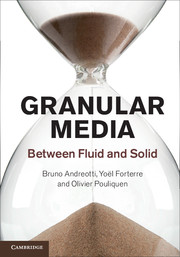6 - The granular liquid
Published online by Cambridge University Press: 05 June 2013
Summary
Most granular flows encountered in nature and industry lie between the quasistatic and gaseous regimes seen in the previous chapters. In this intermediate ‘liquid’ regime, particles remain closely packed and interact both by collision and through long-lived contacts. Understanding and modelling the flow of dense granular media is challenging and many questions remain to be answered, despite important advances having been made during the last decade. In this chapter, we first present the basic features of dense granular flows (Section 6.1), before focusing on the rheology of this peculiar liquid (Section 6.2). A phenomenological constitutive law that is based on dimensional analysis is presented, in which the medium is described as a viscoplastic fluid with a frictional behaviour. The success and limitations of this approach are then discussed, in particular close to the solid–liquid transition where complex collective behaviours are observed. The second part of the chapter presents a hydrodynamic description of dense flows that is valid for a shallow layer flowing under gravity (the Saint-Venant equations) (Section 6.3). This depth-averaged approach enables one to gather the complex rheology into a single basal friction term and is commonly used in geophysics to describe rock avalanches and landslides. We close the chapter with a presentation of the phenomenon of size segregation, which occurs when the medium is composed of particles of different sizes. The consequences of segregation for polydisperse granular flows in various configurations are presented (Section 6.4).
- Type
- Chapter
- Information
- Granular MediaBetween Fluid and Solid, pp. 215 - 284Publisher: Cambridge University PressPrint publication year: 2013



